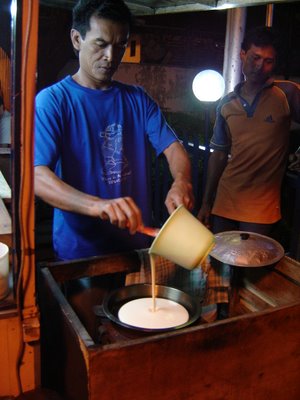
Ganes doesn't shy away from hyperbole ("a tale fully flowing with tears and blood!"). He likes a good plot twist. When you have to look up every second word in the dictionary, you need frequent rewards, and Ganes is rich in rewards.
Interestingly, A Visit in the Middle of the Night (above) is Christian: a handsome guy decides to kill his sickly wife so he can marry her pretty friend but (gasp!) She's Not Really Dead!!! and she develops the inconvenient habit of turning up at midnight wearing flowing white robes. But the evil husband gets saved by the local church and turns into a nice guy, and everyone lives happily ever after.

Ganes's most famous character is Si Buta dari Gua Hantu, the hero of Mystery at Borobudur. Si Buta appears to be Muslim, and he's blind; his name means the Blind One from Bat Cave. I'm only partway through Mystery at Borobudur, so I can't tell you much, but it involves a sweet girl, two evil brothers, a secret treasure, and the last wish of a dying man. Furthermore, it's set on and around Mt. Merapi ("terrifying Mt. Merapi!!"), which erupts halfway through the book, so it promises to be a humdinger.
According to one website, Ganes had a drama of his own. After art school, he developed some vague association with the Communist Party. Then, during the anti-Communist massacre of the mid-60s - a mass bloodletting that has largely been forgotten, and has never been properly investigated - he decided to give up "art" and focus solely on comic books, since artists with lefty associations often wound up in prison or worse. I won't speculate on what it means to be a stifled artist who draws a blind hero, but clearly Ganes' experience of evil and fear was not entirely imaginary.









